Unlike our four Bloomsbury walks, this is a literary as well as an architectural one. It explores the haunts of Dylan Thomas (1914-53) and his acquaintances and contemporaries, and notes some good buildings as well. For convenience, it starts and ends at Goodge Street Station.
Dylan Thomas worked for BBC wartime propaganda at the Ministry of Information at Senate House, though not at the famous building itself, but if you want to have a look at it before the main walk, you need to cross Tottenham Court Road, go down Chenies Street, turn south into Alfred Place, then left into Keppel Street. Senate House looms at the far end. It was designed by Charles Holden (1875-1960), as the administrative centre of London University, and never completed as planned. Constructed between 1932 and 1937, its Art Deco influence echoes some of Holden's other buildings in Bloomsbury. His London Underground stations, in a European influenced proto-Modernist style, are also famous.
Go back to Goodge Street Station, then west down Tottenham Street, and south down Whitfield Street, having a look at Pollock's Toy Museum
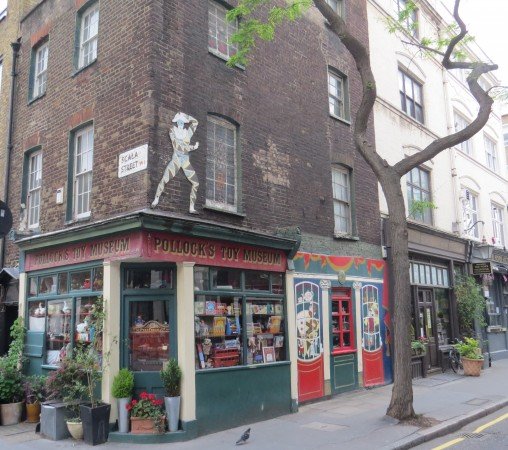
in its little Georgian house on the corner of Scala Street, where some intimate late Georgian terraces survive on the south side. Continuing south, you come to the attractive Colville Place, its houses looking out over Crabtree Fields.
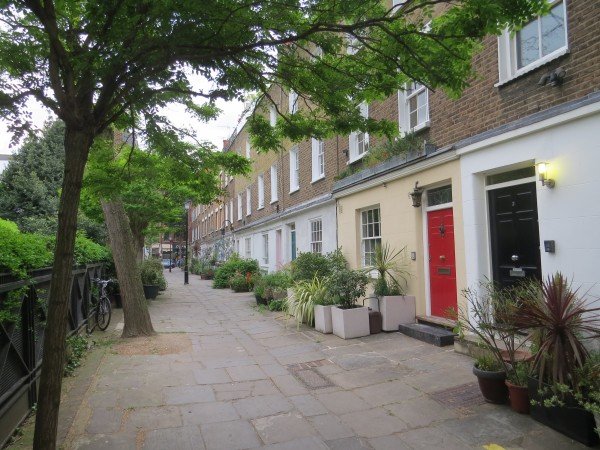
Walk down this little oasis, then turn left into Charlotte Street, with its mix of Georgian and Victorian terraces. At the corner with Windmill Street, another pleasant Georgian street, you come to the Fitzroy Tavern.
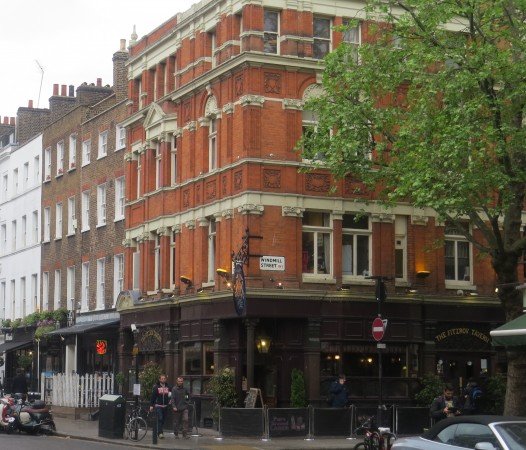
This was the famous hub of Fitzrovia, the heart of London's Bohemia from the 1920s to the 1950s, discovered by the artist Nina Hamnett. Dylan Thomas came to Fitzrovia in 1934, and frequented the pub, as did many artistic, literary and more dubious figures of the war years including Jacob Epstein, George Orwell and Aleister Crowley, as well as politicians like Nye Bevan and Michael Foot. The word ‘Fitzrovia’ was first used in print in 1940 by William Hickey of the Daily Express (Tom Driberg), and verbally by Judah Kleinfeld, landlord of the Fitzroy from 1919 to 1934. Within a year of visiting it, Dylan Thomas had published his first book of poems.
Carry on to the bottom of Charlotte Street, at the corner of a particularly well preserved Georgian street, Percy Street, then a few steps south down Rathbone Place, where only a few Georgian houses now remain, to get to the Wheatsheaf (a little beyond, in Gresse Street, lies the Bricklayers Arms).
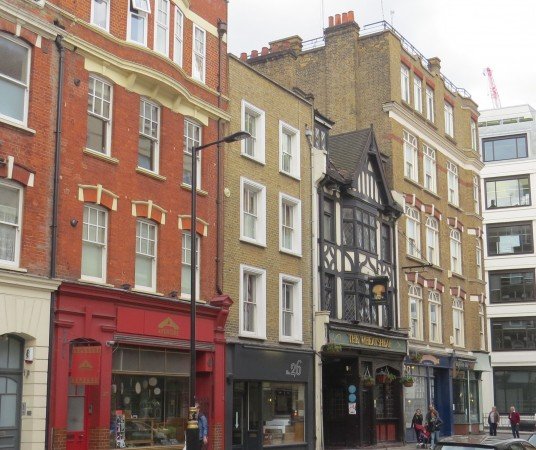
The Wheatsheaf was patronised by George Orwell and Anthony Burgess - bohemian drinkers graduated from the Fitzroy to the Wheatsheaf and others in the 1940s, when Tambimuttu said the Fitzroy had become too well known. In 1936 Dylan Thomas met Augustus John, who lived in Fitzroy Street and had Caitlin Macnamara with him, at this pub. Dylan drank there at John's expense, then calmly took Caitlin off to the Eiffel Tower Hotel round the corner in Percy Street (which has been identified as 1 Percy Street, now the Bam Bou [1]), where they stayed for several days. It was also where Wyndham Lewis and Ezra Pound launched Vorticism with ‘Blast’.
At the corner of Percy Street here near the Wheatsheaf is 28 Rathbone Place, the site of the Rathbone Arts Club, basically just a drinking den in the basement, another of Dylan's haunts, from which he was duly thrown out.
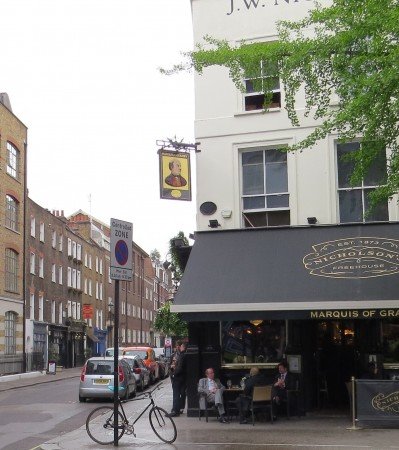
By the way, at the other end of Percy Street, No. 18 is the setting for the room where Julie and Winston have their dangerous affair in Orwell's 1984. Now go back north up Rathbone Street, with its few remaining Georgian houses, past the Newman Arms, on which Orwell's proles' pub in 1984 was based. Don't miss the evocative Newman Passage
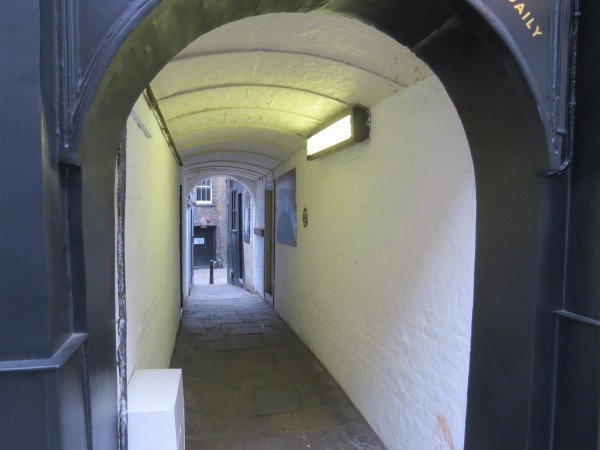
at its side, a still remarkably Dickensian little enclave so close to the hubbub of Oxford Street. Then on up to the Duke of York at the corner of Charlotte Place, where Anthony Burgess drank during his war leave.
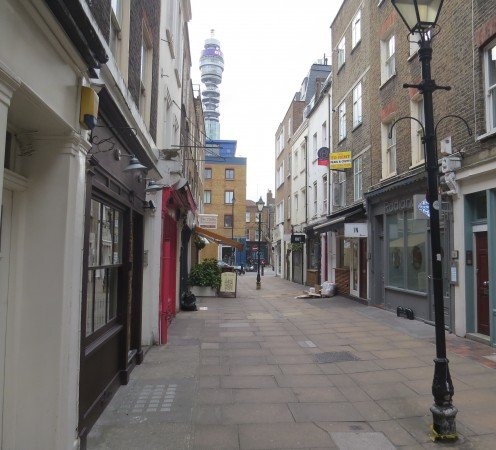
Charlotte Place takes you into Goodge Street, where across the road you glimpse more attractive Georgian terraces in Goodge Place. Turn left, and Goodge Street runs into Mortimer Street, where further on, beyond Wells Street, you pass No. 27, on the south side, and Nos. 34-38 (1915) by Francis Leon Pither,on the north, both delightful ‘Edwardian Medieval’.

You will shortly come to the George, also on this north side, on the corner of Great Portland Street. This pub was frequented by Roy Campbell, the South African poet, Louis MacNeice, Julian Maclaren-Ross with his silver-knobbed cane (the model for Anthony Powell's X Trapnel) , Tambimuttu, the founder-editor of Poetry London and friend of T.S. Eliot (who lived nearby in Bloomsbury), and Orwell. Also, needless to say, by Dylan Thomas, who celebrated Under Milk Wood being accepted by the BBC there, later realising that he’d left the only copy behind. Luckily the landlord had retrieved the beer-stained manuscript.
Up Great Portland Street northwards from here, to the left down Langham Street (opposite the house of D.E.Hughes who invented the microphone), lies the famous BBC Broadcasting House where so many of Dylan's friends and acquaintances worked. Designed by G. Val Myers in 1931 with sculptures by Eric Gill, including his fine Ariel over the entrance, its lumpish appearance proved controversial, though it is now seen as a good building, a verdict only confirmed by the new extension with its trashy glazed panels. From here you can go north up Hallam Street if you want to see yet another Dylan Thomas watering hole, the King's Head on the corner of New Cavendish Street - its late 1920s or 1930s design means it must have been quite new in his day.
Round the BBC southwards from Langham Place lies the cul-de-sac All Souls Place, where the artist and writer Michael Ayrton lived at No. 4. From Langham Place, go south round All Souls Church to Riding House Street which takes you back east, and when you have got some way along here, across Great Portland Street and Great Titchfield Street, have a look at the delightful Art Nouveau houses at the corner of Candover Street. No. 59 is still resplendent with its green mosaic panel advertising T.J. Boulting & Sons.
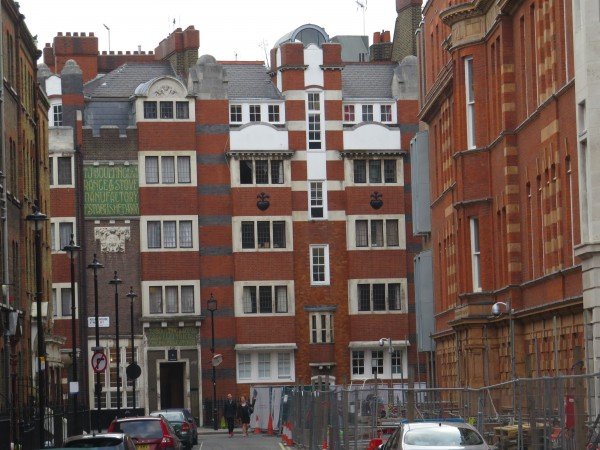
No. 61, Oakley House, is next door, and in Candover Street, York House, Belmont House and Tower House are in similar style. They were all designed by H. Fuller Clark, best known for his famous Art Nouveau pub The Black Friar in the City of London.
Now go up Candover Street, into Foley Street, past No. 40, another good Art Nouveau/Arts & Crafts building, then northwards up Ogle Street past the Church of St. Charles (RC) (1862) and its nice Gothic presbytery (1867), then to Cleveland Street;
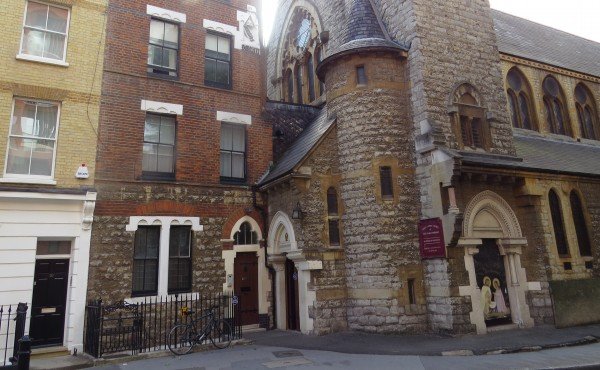
or if you prefer, continue eastwards along Foley Street to see the Gothic King and Queen pub at the corner with Cleveland Street, with the Cleveland Street Workhouse opposite. Saved from demolition, it is one of the last surviving original workhouses in London, with its connection with Charles Dickens, who lived nearby at No. 22.
From Cleveland Street up to Conway Street. Dylan Thomas and Caitlin lived at 8 Conway Street in 1941 (now painted cream) and on the corner, No. 33 Fitzroy Square was the home of Roger Fry and the Omega Workshops.
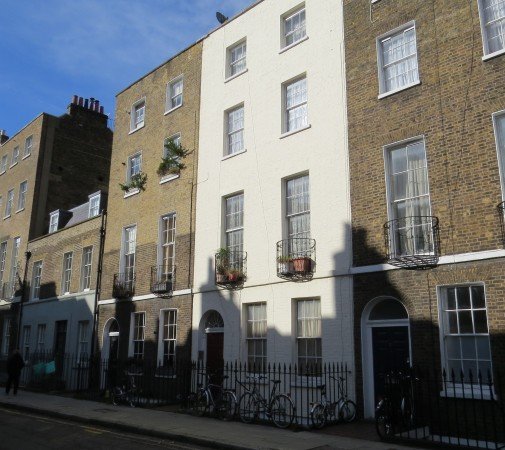
Fitzroy Square, it need hardly be said, is one of the finest squares in London, developed by Charles Fitzroy in the late 18th century, descendant of Henry Fitzroy, the bastard son of Charles II. The south and east terraces were designed by Robert Adam (1728-92). Go on through Fitzroy Square to get to Fitzroy Street - Dylan and Caitlin also lived there at No. 12 in 1944, now a glass office block. [2]
Going on south down this now sadly bleak stretch of Fitzroy Street [3], which turns into Charlotte Street (No. 81 was the home of Sir Robert Smirke, architect of the British Museum), you get back to Tottenham Street, thence to Goodge Street Station.
[1] Mike Pentelow and Marsha Rowe, Characters of Fitzrovia, Chatto & Windus/ Felix Dennis (2001).
[2] DT also lived for a while in Rugby Street, Bloomsbury. TS Eliot lived in 1914 at 28 Bedford Place, and later worked in a room at 24 Russell Square from 1925 until his death in 1965, as a director of Faber & Faber. DT called him 'Pope Eliot'. He complained that his poems were difficult to follow but was still happy to sponge off Eliot's generosity - Richard Tames, Bloomsbury Past, Historical Publications Ltd. (1993), p. 95.
[3] Or go left into Maple Street and south back to Goodge Street Station via Whitfield Street, marginally better than this stretch of Charlotte Street.